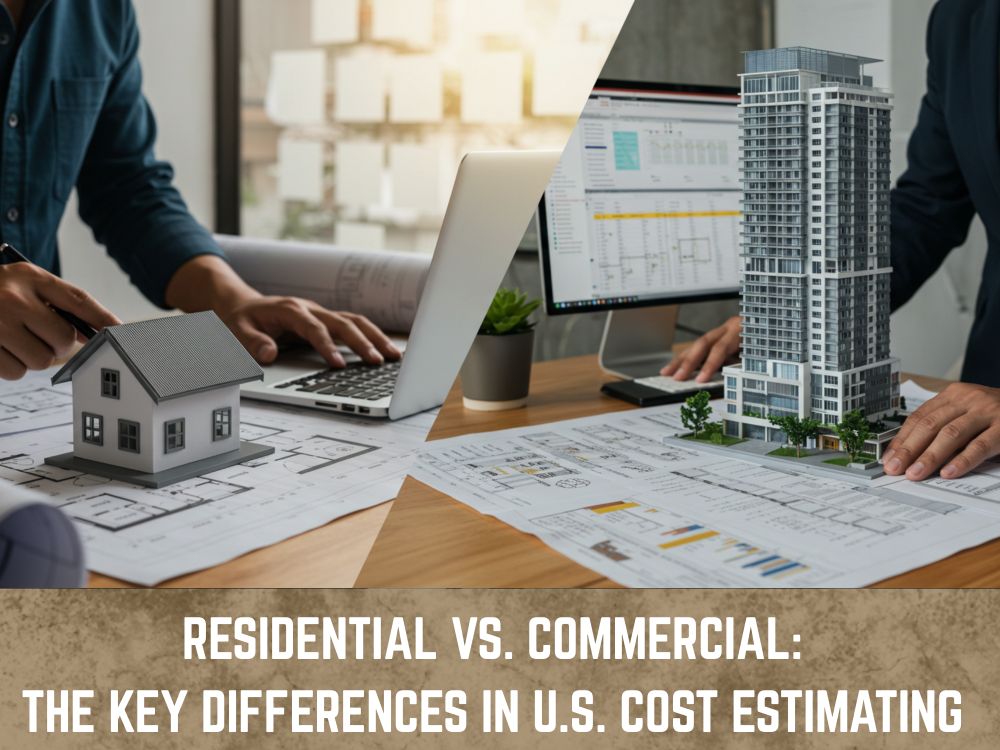For a cost estimator, not all construction projects are created equal. While the fundamental principles of estimating—identifying materials, labor, and overhead—remain the same, the devil is in the details. The world of residential construction and the world of commercial construction are two distinct ecosystems, each with its own set of challenges and complexities. For an estimator, understanding the key differences is not just important; it’s the single most critical factor in ensuring an accurate, profitable bid.
Misapplying residential estimating methods to a commercial project, or vice versa, can lead to catastrophic financial outcomes. Here’s a deep dive into the key distinctions in U.S. cost estimating between these two project types.
1. Scope, Scale, and Complexity
The most obvious difference lies in the project’s scale and complexity.
Residential Projects: Typically involve single-family homes, duplexes, or small-scale apartment buildings. The scope is generally focused on a few core disciplines: structural, mechanical, electrical, and plumbing (MEP). While custom homes can be complex, the overall scale is manageable, and the designs often follow established residential building codes (e.g., the IRC). The number of stakeholders is usually limited to the owner, an architect, and the contractor.
Commercial Projects: These projects, which include office buildings, retail spaces, hospitals, and schools, are on a completely different level. They involve multiple floors, complex HVAC and electrical systems, and a wider range of specialized trades. A commercial project can require a vast array of disciplines, from fire protection and elevator systems to advanced security and data networks. The sheer number of systems and the intricate coordination required make the estimating process far more detailed and rigorous.
2. Materials and Specifications
The choice of materials and the level of specification documentation are major differentiators.
Residential Projects: Material choices are often a mix of owner preferences and standard, readily available materials from local suppliers. Specifications are usually less formal and may be noted directly on the blueprints. While quality varies, the focus is on standard-grade materials that meet residential code requirements. This can make estimating simpler, as product options are more limited and costs are more predictable.
Commercial Projects: Specifications are formal, highly detailed, and can run for hundreds of pages. They are a binding legal document that dictates everything from the brand of every fixture to the exact composition of the concrete mix. Materials used in commercial construction must often meet more stringent performance, durability, and fire-rating standards. This requires the estimator to be an expert at reading and interpreting complex spec books, which often contain specific submittal requirements and testing procedures that add both time and cost to the project.
3. Labor and Specialization
The labor pool and the cost of labor are distinct between the two sectors.
Residential Projects: Often rely on a core team of general laborers and a few skilled subcontractors, such as plumbers and electricians. The workforce is typically smaller, and a single person may be responsible for multiple tasks. Labor rates tend to be lower than in the commercial sector.
Commercial Projects: Demand a highly specialized workforce. Commercial work is often unionized, which means higher, fixed labor rates. Projects require a multitude of specialized subcontractors for systems like fire suppression, building automation, and structural steel. The estimator must account for these different rates, union-mandated benefits, and potential overtime costs, making the labor component a more intricate part of the estimate.
4. Code Compliance and Regulations
Code compliance is where a simple mistake can lead to major financial fallout.
Residential Projects: Primarily fall under the International Residential Code (IRC), which is generally simpler and less restrictive than commercial codes. While safety and structural integrity are paramount, the number of required inspections and the complexity of the regulations are typically lower.
Commercial Projects: Are governed by the International Building Code (IBC), which is significantly more complex. Commercial projects must also comply with a host of other regulations, including the Americans with Disabilities Act (ADA), local fire codes, and strict zoning and environmental laws. Every aspect, from the width of a hallway to the number of accessible restrooms, is dictated by these codes. The estimator must be an expert in these regulations, as a single non-compliant design element could result in a costly re-design and re-estimation.
5. Risk and Contingency
The level of risk and the necessary contingency budget are significantly different.
Residential Projects: The primary risks often relate to client-driven changes or unforeseen site conditions. While serious, the financial liability is usually contained. A contingency budget of 5-10% is often sufficient.
Commercial Projects: The risks are far greater and more varied. They include:
- Market Fluctuations: The long timeline of commercial projects makes them vulnerable to material price volatility.
- Coordination Challenges: A delay by one subcontractor can trigger a domino effect across the entire project.
- Regulatory Changes: A code change during a multi-year project can necessitate a costly redesign.
Due to these factors, commercial estimates require a more substantial contingency budget, often in the range of 10-20% or even higher, depending on the project’s complexity and risk profile.
6. Bidding and Contractual Agreements
The bidding process and the contracts themselves are unique to each sector.
Residential Projects: Bidding is often less formal, with contractors submitting a proposal based on a rough estimate. The contract may be a simple fixed-price agreement with change orders for any modifications.
Commercial Projects: The bidding process is highly structured and competitive. It often involves a formal Request for Proposal (RFP) with specific submission deadlines and requirements. The contracts are legally binding, comprehensive documents that include detailed terms for payments, schedules, and risk allocation. An estimator must not only be accurate but also understand the legal and financial implications of the contract.
Conclusion
Residential and commercial construction are two different languages of cost estimating. While both require attention to detail, a commercial estimator needs to be fluent in the language of complex systems, formal specifications, and a dense regulatory environment. A residential estimator must be adept at balancing client expectations with practical, cost-effective solutions. By recognizing these fundamental differences, contractors can ensure their bids are not only competitive but also based on a solid, accurate foundation, leading to financial success and a reputation for reliability in a demanding industry.




